Underrepresented on the Road
The #vanlife trend on social media presents this lifestyle as young, heterosexual, non-disabled, and white. Meet the nomads working to change that narrative.
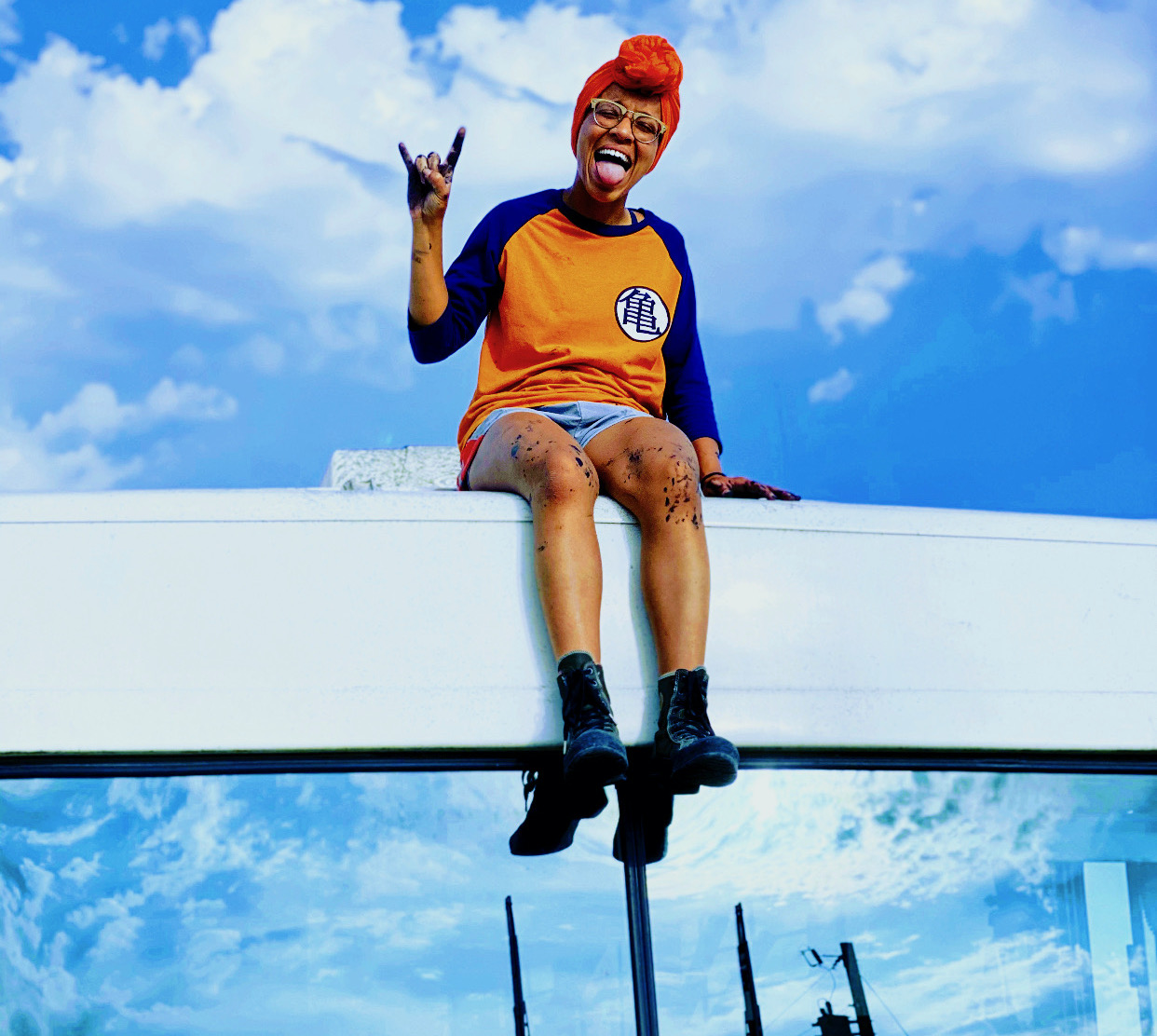

It took time, a break-up, some soul-searching, and an expensive apartment to push Kathy Karlo into becoming a full-time nomad. In a 2014 post on her blog titled, “Grown-ups Don’t Sleep in Their Cars!,” she described the shame she felt being a 20-something who loved to climb rocks and the pressure she felt to earn a bachelor’s degree and be serious about her career. Meeting others amplified those feelings. They emphasized how her job status and ever-changing location due to frequent rock-climb road trips in her Honda telegraphed to others as lost and future-less. But she saw things differently. “In some ways,” she writes in the post, “I am convinced that mudding through my life the same way I have always gone through it will lead me to wherever it is that I’m going or supposed to be.”
Karlo, the 34-year-old climber and creator behind the blog For the Love of Climbing, has been living nomadically for the last seven years. However, her upbringing featured little nature, few excursions into the great outdoors. She was born in Seoul, South Korea, adopted by American parents, and raised in New Jersey. But in her mid-20s, her boyfriend at the time who was from Colorado started to take her ice climbing, and she went from someone who had never pitched a tent to someone who scaled rocks and cliffs covered in frozen water. That was “their thing” for two years before they split up. But the relationship helped Karlo discover the activity that has kept her traveling around the country for more than seven years: rock climbing.
In fact, Karlo decided to become nomadic to facilitate her ability to climb where she wanted. “Every other part of my life just kind of disappeared, and I was pretty one-dimensional for a little bit,” Karlo says. “I just wanted to climb as much as I could and be outside.” Based in Brooklyn, New York, she paid $1,000 in rent for an apartment she often left for days to travel up and down the East Coast for climbs. For those trips, she lived in her car, making her a part-time nomad. But in 2014, she sold her possessions (admittedly, there wasn’t much), left New York, and made her Honda CR-V a home. Since then, she’s relocated several times and upgraded to a Nissan NV Cargo van.
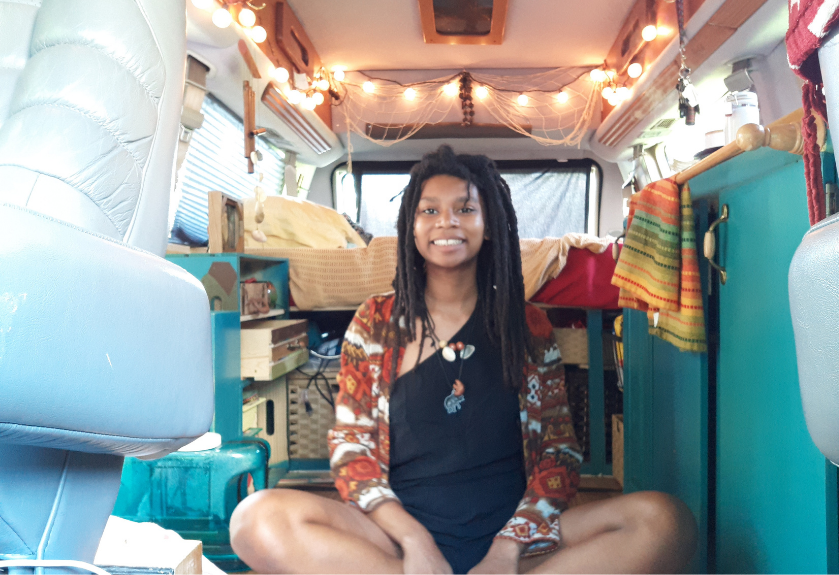
Kadedra Holmes started Black Nomads Meet as a way to create community. “As we grow to become more relevant in the nomadic community,” she says, “we're also in a way breaking down those systems that have tethered us to areas that are not healthy to live in.” Photo courtesy of Kadedra Holmes.
Many others who share Karlo’s wanderlust have joined her on the road. Last year, vanlife got a surge of attention as some Americans chose to continue to travel during the pandemic. The #vanlife tag on Instagram boasts more than 9.5 million posts. At the start of this year, the hashtag was at 7 million posts, an increase of 312% since 2017, according to a survey by Outbound Living, a blog that centers on nomadic living and vanlife experiences. The lifestyle even earned big-screen attention: The 2020 film Nomadland features real-life nomads and earned several awards at the 93rd Academy Awards, including Best Picture, Best Actress for Francis McDormand, and Best Director for Chloé Zhao, which made her the first woman of color and the second woman to win that award. However, many critics noted the film’s whitewashed narrative. Writer Jeremy Helligar wrote in his critique of the movie: “Basically, it’s a movie about White people problems featuring the sort of disillusioned White Western Americans that, in my mind, contributed to the regrettable rise of Donald Trump.”
Social media portrays #vanlife as a niche lifestyle that highlights minimalism, sustainability, nature, and an overall granola-ness that looks inaccessible to those from marginalized groups.
The #vanlife trend on social media also presents as extremely young, heterosexual, and caucasian. In fact, the top-rated vanlife posts consist of either white solo travelers posed inside their mobile homes with tribal print blankets, drinking coffee out of thermal canteens, or a white and straight couple posed proudly in front of their vehicle embracing or holding hands in slightly coordinated flannel or athleisure outfits, oftentimes featuring a dog. But vanlifers such as Karlo are working to change the narrative to what they know to be true: That the outdoors belongs to everyone, especially those whose identities of race, gender, sexuality, ability status are marginalized. “I mean, they call nature and the great outdoors ‘the great equalizer’,” Karlo says.
While popular images on social media platforms present a partial, constructed view of the outdoorist lifestyle, Karlo tries to engage and encourage deeper conversations through her podcast, which is now 26 episodes and eight “mini” episodes in. Guests on her show discuss different intersectional issues that climbers face — from male body positivity to inclusivity, racism, and post-traumatic stress disorders that impact people in their outdoor space. The banner on her site’s homepage proclaims, “This is not a climbing podcast. Well, sorta.” The podcast also helps Karlo work through personal traumas she’s experienced in her years on the road. She says she wants to speak her truth and that her blog offered a way to rebuild and reaffirm a new community after she lost her previous one in 2018 when she survived a sexual assault.
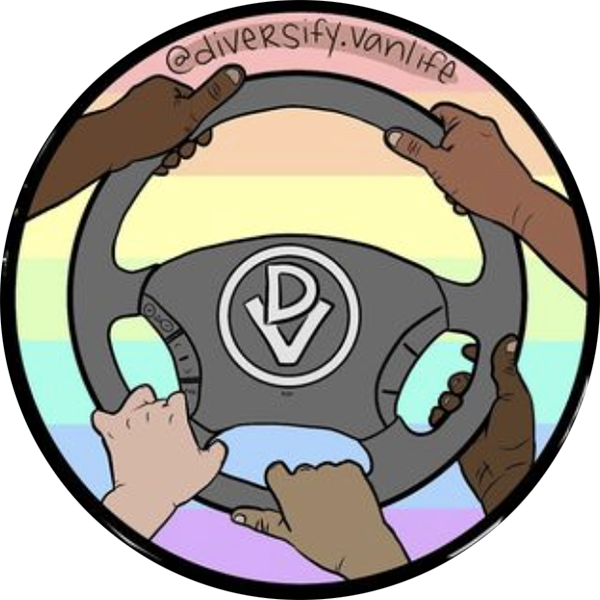
Founded by Noami Grevemberg, the Diversify Vanlife team highlights BIPOC, LGBTQIA2S people, and people with disabilities on their Instagram account (23.7k followers). The team's Nomads at the Intersections podcast augments that content with interviews with nomads who possess an engaging range of different experiences such as hiker, nomad, and full-time beadwork artist Wynnē Weddell, who is a Native American of the Yankton Sioux Tribe.
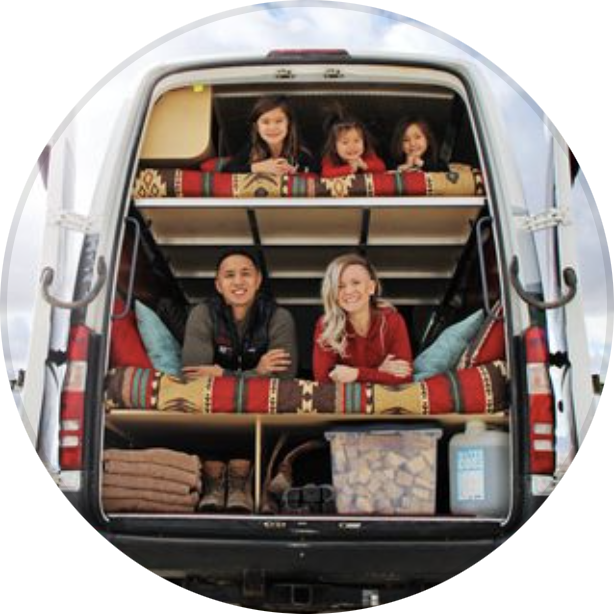
Vanlife is not exclusive to solo travelers. In fact, whole families tackle the road together. Exhibit A: Rachel and Michael Sanchez are a couple with three young daughters and another child on the way. They have been a part-time #vanlife family since 2020, and their Instagram offers their over 8.5k followers an inside view of how that works. The account gives a range of detailed advice, such as how to layer a child for winter travels to handling heat stroke during a hike.
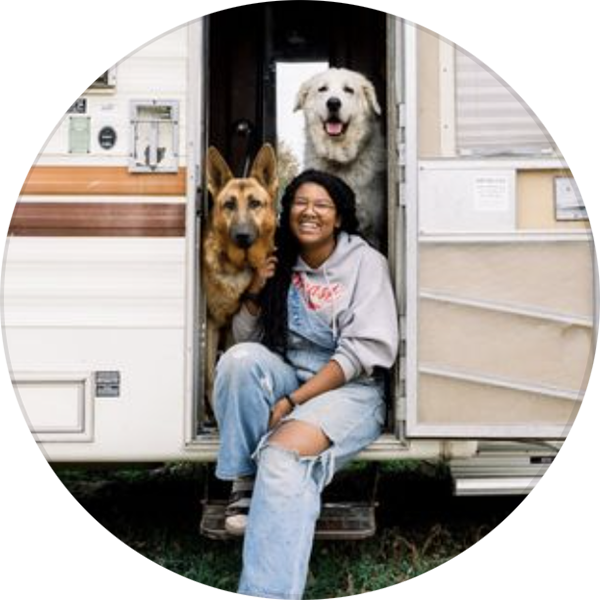
A nonbinary vanlifer from Texas who travels with their two dogs, Jupiter posts commentary on social issues such as abortion rights and shares personal posts about gender identity or neurodivergence. Jupiter’s instagram account has collected over 13.7k followers and continues to grow as a window into the world of #vanlife. They also launched a YouTube channel at the end of 2020, which provides in-depth information about the realities of van maintenance.
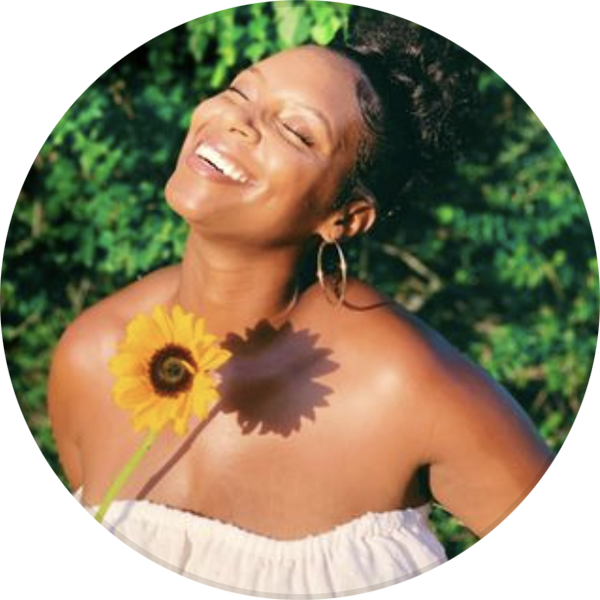
The self-titled “Beyoncé of VanLife,” Candyss Love wears many hats on her #vanlife journey — a soul coach, mentor, and social-media content creator who uses her platform to help others heal from their trauma. With over 34k Instagram followers, Candyss documents her #vanlife experience through posts and stories. Candyss offers one-on-one #vanlife Q&A sessions for $50 for 30 minutes. She also owns a natural skincare line, Sasha Flowers Intentional SkinCare.
But the term “community” is complicated for Karlo. After she left New York, she transitioned between traveling and living out of her car and settling in and establishing a home base. She settled in Salt Lake City, Utah, and created a network of solid relationships with climbers there. But she lost it, she says, when she needed it the most — after her assault. “It actually caused a huge rift in my community,” she says. “My sense of it all, it really did crumble.” She decided to leave the environment and the people who no longer supported her and spent a lot of her time that year traveling alone, trying to grieve. Karlo hasn’t settled into a home base since then and is fully nomadic. She says vanlife offered a form of escapism, but it also aided in her healing process.
“Found community versus the community created is so different,” Karlo says. “What I've gained now is beyond comparison or price, because I think I've just refocused my energy on people who really deserve my time and love.”
Social media portrays #vanlife as a niche lifestyle that highlights minimalism, sustainability, nature, and an overall granola-ness that looks inaccessible to those from marginalized groups. Kadedra Holmes, founder of the Black Nomads Meet project says that this curated lens fails to capture the reality of the lifestyle. She says Black nomads like herself bring a distinct perspective to the experience and combat stereotypes that Black people don’t leave their communities or enjoy the outdoors. “A lot of that comes from post-slavery and being tethered to the land, and even being afraid to travel for your safety,” Holmes says.
When Holmes first began living in a van two years ago, she and her ex-partner mainly sought a way to save money by avoiding paying rent for an apartment. The move felt natural for her because she grew up traveling the country with her parents and other family members. While vanlife started as her individual endeavor, it soon became a new way for her to build community with people in the lifestyle that looked more like her.
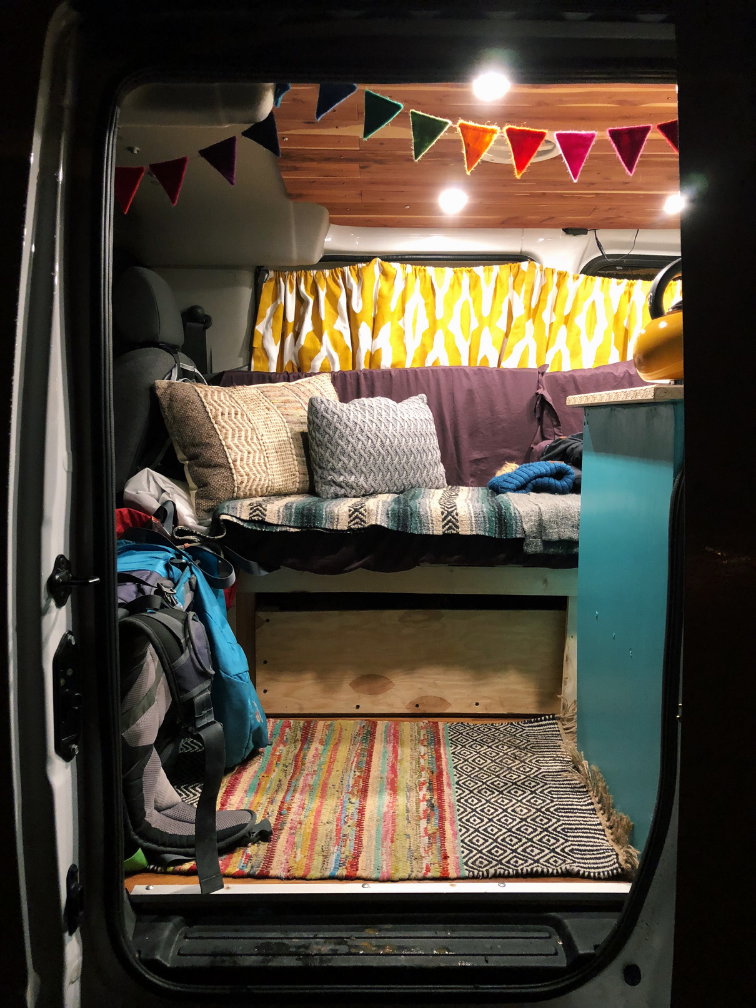
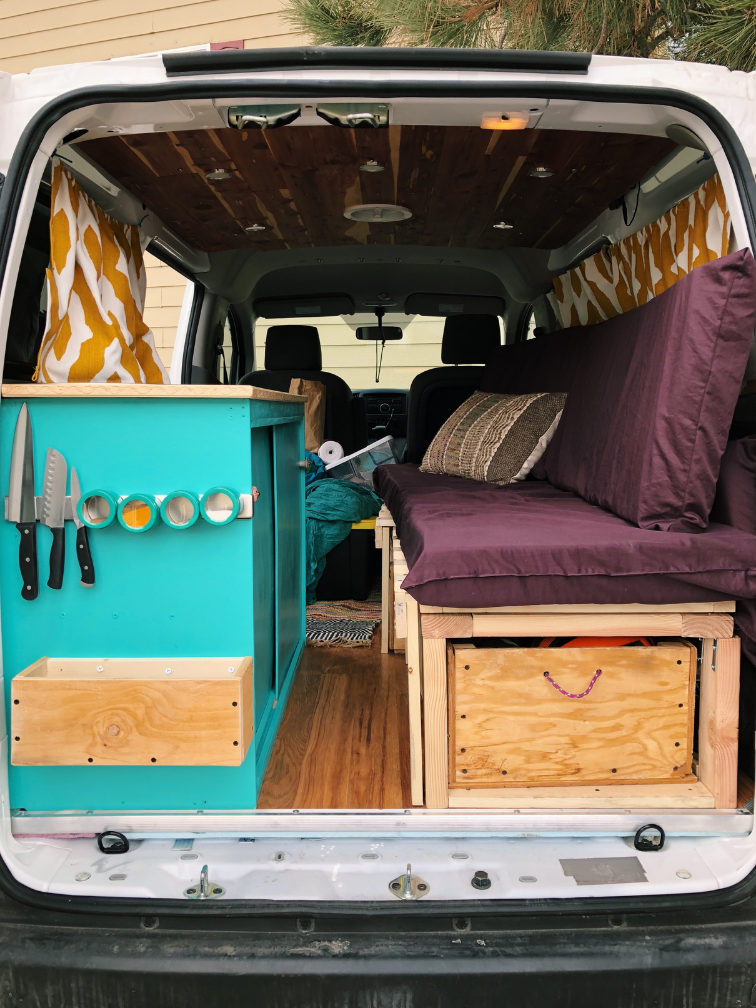
Kathy Karlo notes that a significant part of living in a van is the isolation, which is both intimidating and healing for her. “That’s when you’re truly by yourself. You really give yourself that space to breathe and reflect,” says Karlo. Photo courtesy of Kathy Karlo.
Holmes started Black Nomads Meet as a way to bring together Black people in the vanlife, nomadic, and tiny home communities. “As we grow to become more relevant in the nomadic community, we're also in a way breaking down those systems that have tethered us to areas that are not healthy to live in,” Holmes says. “[Vanlife is] pushing us into places that really serve us.” Last August, her team held a virtual version of Black Nomads Meetup, but their first in-person event will be held over one weekend in June in Warthen, Georgia. Holmes has worked in event management for eight years, typically planning health-based initiatives in Black communities and underserved neighborhoods. For Holmes, seeing Black people connecting in a unified space delivers an “ultimate” experience.
The summer meet-up features Black-owned business vendors such as Sasha Flowers Intentional SkinCare and Rooted-n-Nature Natural Bodycare Products, recreational activities such as painting and yoga, and educational workshops and panels about homeschooling on the road and building a digital career as a nomad.
While vanlife veterans such as Holmes and Karlo possess years of experience, the pandemic and quarantine restrictions brought new attention and interest. Vans, once converted into sleepers, provide a resource to those still itching to travel, and are willing to make the investment, to avoid public transportation such as planes, trains, and buses where it’s uncertain who may be infected with COVID-19.
Gaby Phillips is on schedule to make that move after she finishes her senior year of college at Syracuse University. Around the beginning of lockdown restrictions in 2020, she, her girlfriend Skye, her twin sister Halle, and Halle’s boyfriend Matt made a plan to renovate a bus they bought off of Facebook Marketplace for the four of them to journey in the summer of 2021. They’ve been working on their bus, Beanie, between school semesters and work, and documenting their progress on Instagram, YouTube, and TikTok.
Even though she travels in a group, Phillips says that she and Skye make it a point to reach out to other vanlifers from the LGBTQ+ community on Instagram, especially through the account Vanlife Pride, which highlights the community of queer nomads. “We follow a few accounts that are families traveling in a van with two moms or two dads, same-sex couples, a lot of nonbinary people,” Phillips says. “Talking to the couples, it’s been great, and a lot of the time it’s not even centered around their identities.”
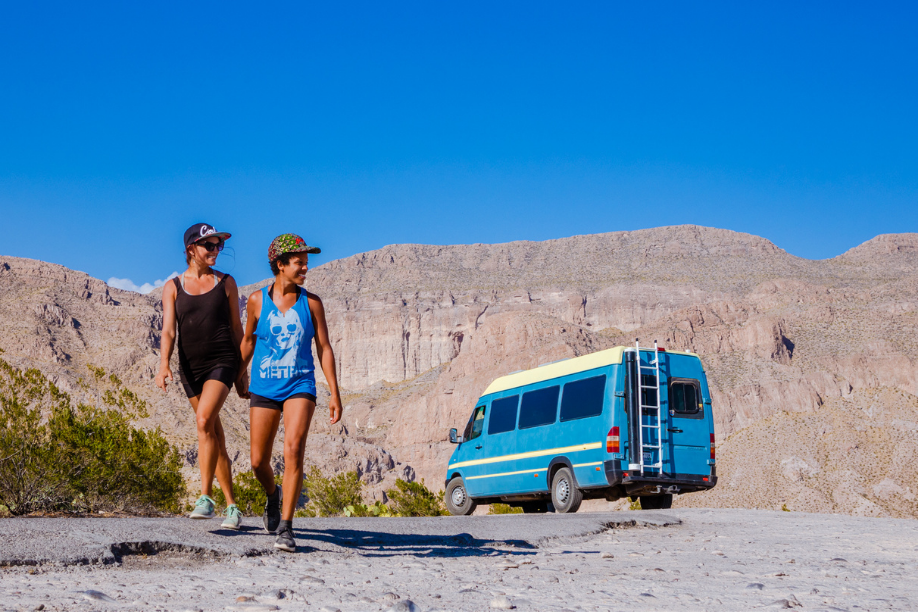
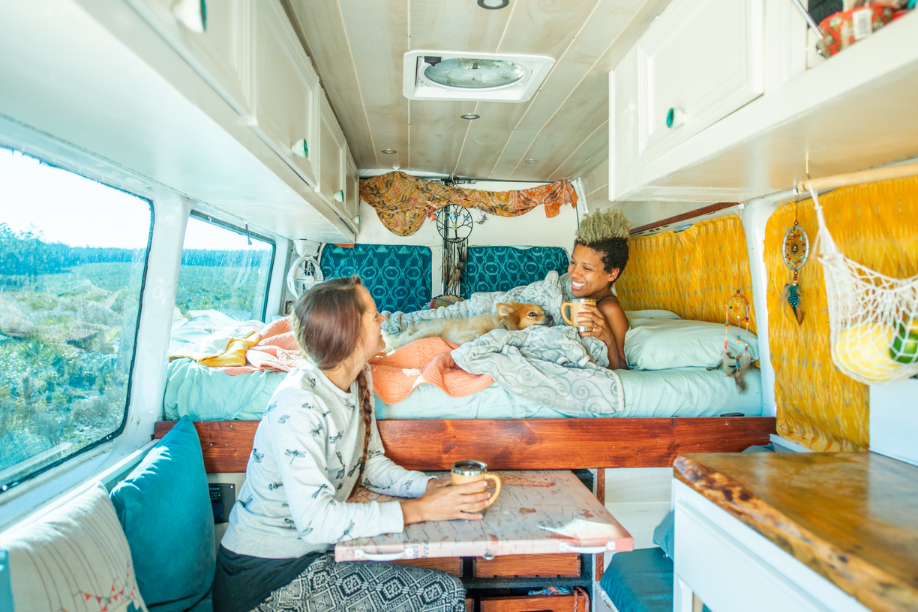
Natalie Rodriguez (right) used to work over 50 hours a week as a sous chef in a kitchen before she and her now wife Abigail Rodriguez (left) chose vanlife. The couple desired to spend more time with each other and to live a more minimalist lifestyle. “Some people are like, ‘How do you deal with living in such a small space?’ Well, we spend a lot of time outside.” Photo courtesy of Abigail Rodriguez.
Vanlife Pride is run by Abigail and Natalie Rodriguez, a lesbian couple that decided to commit to nomadic living in 2017 and began traveling in 2019. Abigail says that they got into vanlife as a way to spend more time with each other. “[Natalie] was a sous chef and was working like 50 hours a week,” Abigail says. “We thought, well, what if we could find a way to live with less, have more time together and more experiences?” It took them two years to save for and convert the van while working full time. Not to mention they married during this time and moved into the van three months after their wedding. These days, they’re off the road redoing their van to prepare for travel to Alaska and Argentina this summer (if border restrictions allow). “Natalie is a really good driver, and she doesn't do well in the passenger seat, so she drives and I navigate,” Abigail says. “She does certain tasks in the van and I do others and we are constantly telling each other how much we appreciate each other. Little things go a long way when you're living in such tight quarters.”
The two use a YouTube channel and personal page on Instagram called Let's Play Ride and Seek, which began as a way to document their adventures for friends and family. The YouTube channel has 6,800 subscribers, and the Instagram has 21,000 followers. As they got deeper into the vanlife community, they struggled to find other LGBTQ+ people represented on social media, and they wanted to find them and connect. Abigail says they found inspiration in Diversify Vanlife, a platform founded by Noami Grevemberg that showcases all types of people in vanlife that identify as BIPOC, LGBTQIA2S, and people with disabilities.
Phillips says she often must consider her identity as a gay woman when she travels with Skye. When they’ve gone abroad to other countries together, they search whether or not it’s safe for them to be a couple. When they visited Vietnam together, they presented themselves as friends, an abnormal experience for the two.
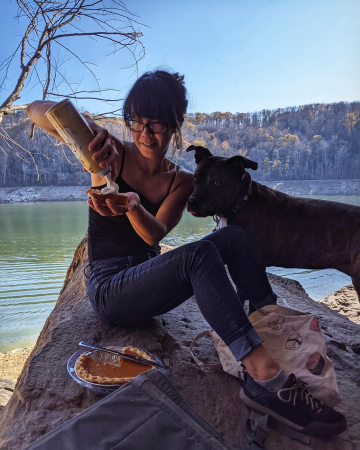
The social media representation of outdoorist living is “shiny, happy stories,” according to Kathy Karlo. While Karlo thinks this is not completely inaccurate, she uses her podcast For the Love of Climbing to have conversations about the burdens and struggles of people in her community. Photo courtesy of Kathy Karlo.
Looking forward, Phillips believes that vanlife will offer an empowering experience for her group, and they plan on taping interviews with the new people they meet. “I identify as a gay woman, but we all are white, and we do understand that that contributes to us feeling comfortable or us seeing ourselves represented in these outdoor spaces,” Phillips says. She wants to show people following their journey to take this message from it: Regardless of identity, a space exists for you in this community. “We’re interested in all these different accounts that we find and all these different people that we find,” she says. “That’s what I'm most excited for is to be on the road and meeting people that I probably would've never met otherwise.”
Phillips’ current goal exists as Karlo’s reality. She describes her blog as a passion project and her conversations with climbers on the podcast as a privilege. Her experience being a part of different climbing communities for a decade allows her to see changes in the way people acknowledge diversity and inclusion in these spaces. In fact, she’s noticed more “faces” of diversity, racial identity, gender, ability, and status being recognized more in the community even though the outdoor industry remains overwhelmingly cisgender, male, white, and able-bodied. There’s always some pushback against those initiatives, often by cisgender white males in the community that Karlo says may deny that issues like racism, sexism, and homophobia exist among outdoorists because they don’t experience those issues themselves. But Karlo believes that if outdoorists continue to ask themselves how they can challenge disparities in their community, then all of these conversations are worthwhile. “That’s the wheel of change,” says Karlo. “It’s very slow, but it’s progress.”

Our pursuit of outdoor joy is remiss without the acknowledgement of the occupation of unceded Indigenous land. We are students and journalists working, writing, and living on the land of the Haudenosaunee Confederacy, comprising the Six Nations made up of the Mohawk, Onondaga, Oneida, Cayuga, Seneca, and Tuscarora nations. However, acknowledgement is not enough. Read More.